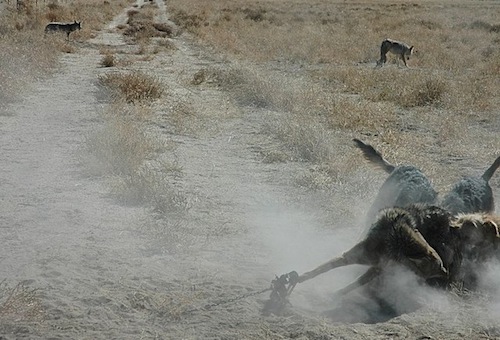
In a series of outstanding articles, investigative reporter Tom Knudson of the Sacramento Bee has pulled back the veil on an ironically named government agency, Wildlife Services. Using interviews, documentary research, the Freedom of Information Act, and whistle-blowers, Knudson reveals a troubled agency whose ethics and science are deeply out of line with sound environmental policy. You can read his series starting with The Killing Agency.
Wildlife Services has killed approximately half a million of animals since 2006, employing traps, snares, poisons, aircraft, and firearms. It’s work is largely at the expense of the public, and primarily for the benefit of private agricultural interests. It’s methods are demonstrably indiscriminate and inhumane, and result in the unintended deaths of tens of thousands of non-target species. This includes household pets and animals protected under the Endangered Species Act.
Wildlife Services also has a long history of hostility towards predators, something inherited from its original mandate to exterminate wolves, coyotes, mountain lions, bobcats, bears and other predators from the United States. This antipathy to carnivores could not be more out of step with our modern ecological knowledge of the crucial role predators play in healthy landscapes.
Suggestions for reforming Wildlife Services abound. They include a greater emphasis on non-lethal methods, education on coexisting with wildlife, protecting native biodiversity, changing it’s cowboy culture, congressional investigations, legal action, overhauling it’s mission, and closing the agency altogether.
Something that has not yet been discussed in detail, however, is the indispensable need for ethical review.
Governments, corporations and universities routinely use ethics panels to examine policies and activities that might harm people, animals or the environment. They are used in medicine and health care, biological research, social scientific studies, and environmental planning. Ethics panels can help doctors, scientists, policy makers, and citizens make good faith decisions that protect our well being, while still accomplishing important private and public goals, such as developing new disease fighting drugs or saving endangered species.
In the case of Wildlife Services, ethical review should start with the generic environmental impact statement that guides the agency’s policy and management decisions. It should then be used to assess the need for and implementation of it’s various scientific, educational and field-based programs. Ethics training should be mandatory for all Wildlife Services staff and cooperators. And daily management should be guided by a set of ethical rules-of-thumb to help field staff make the best decisions they can about lethal and non-lethal control.
Pie in the sky? Not at all.
I was the ethicist asked by the U.S. Fish and Wildlife Service to help design and facilitate a similar ethical review. The case in question was whether to conduct a removal experiments on Barred Owls who were competing with and threatening the Northern Spotted Owl. Using a process termed ethics-based policy dialogue, we conducted ethics training, focus groups, field trips, and roundtable discussions to clarify the ethical issues at hand. We wanted the full range of views on the table, so we include representatives from diverse communities — animal rights, wildlife rehabilitation, environmental, corporate, and relevant agencies of the federal and state governments. We undertook this ethics review as part of the scoping process of an environmental impact statement, and the reviews recommendations are included in the draft EIS currently available for public comment. While the vast majority of us eventually decided that lethal removal was acceptable if regrettable, we did so in the knowledge that a substantial study of the full range of ethical considerations had been completed.
Any agency that affects the lives of so many animals requires periodic ethical review. Without such a system in place, the agency risks running off the rails. I have met many Wildlife Service staff who would welcome an ethics review, but are not in a position to challenge the agency or its culture. So the decisions and practices of Wildlife Services remain ethically unaccountable.
In light of the Sacramento Bee’s reporting, the leadership of Wildlife Services has a golden opportunity to get ahead of the curve and institute a robust ethics review process. If they do so, they might begin anew with both the American people and North America’s wildlife. Let us all hope they see this moment as an opportunity to act, not a time to stonewall.
Image: The image is from the Sacramento Bee, part of a gallery that accompanies Knudson’s articles. The caption to this photo reads: “Three coyotes caught in leg hold traps, at top and foreground, await death in this photo taken by a Wildlife Services trapper in Nevada. The coyote in the foreground is being attacked by the trappers dogs. Leg-hold traps are used by the agency to capture and kill 10,000 to 12,000 animals a year. Roughly half are coyotes, but more than two dozen other species are also targeted, including black bears, muskrats, mountain lions and wild pigs. Leg-hold traps have been banned in many countries”.